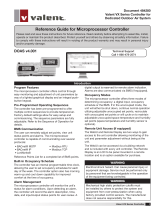
Improper installation, adjustment, alteration, service or maintenance can
cause property damage, injury or death, and could cause exposure to
substances which have been determined by various state agencies to cause
cancer, birth defects or other reproductive harm. Read the installation,
operating and maintenance instructions thoroughly before installing or
servicing this equipment.
Controller
Buttons
Function
Description Controller
Buttons
Function
Description
ALARM
When one or more alarms are active the ALARM
button will blink/ash red. Pressing the ALARM
button once will indicate information regarding any
active alarms. Pressing the ALARM button twice
will reset any active manual-reset alarms.
UP
Pressing the UP button can either:
Scroll through the various display screens,
provided the cursor is in the top left position.
Increase the value of a setpoint adjustment.
PRG Pressing the PRG button will select the main
navigation menu. ENTER
Pressing the ENTER button will conrm any
setpoint adjustments and move the cursor to
the next available setpoint.
ESC Pressing the ESC button will return the user to the
main display screen showing unit status. DOWN
Pressing the DOWN button can either:
Scroll through the various display screens,
provided the cursor is in the top left position.
Decrease the value of a setpoint adjustment.
Controls System Quickstart Guide
Packaged Ventilation/Dedicated Outside Air System (DOAS)
model MPR
a. Install unit in desired location in accordance with the Installation and Maintenance Manual that shipped with the unit. Note: Controller will not be powered
until unit has appropriate electrical connections and disconnect switch in “ON” position.
b. If display module is not unit mounted, connect pGD1 handheld module using RJ-12 communication cable provided in port J10 as shown on unit mounted
wiring diagram.
a. The main
screen (shown at right) is the default navigation page, and can always be recalled by pressing . This may
need to be pressed more than once depending on which menu is active.
b. By pressing you are able to scroll through the display screens which provide information about the current system
operation (examples include temperatures, output status, and space demand).
a. Enter the main menu by pressing and scroll down to line ‘A. On/Off Unit’ and press .
b. Press to move cursor, to ‘Power By Display’ line and the or arrow to change the value between
‘ON’ and ‘OFF’. This parameter must be ‘ON’ for unit to have any functionality (shown at right).
a. Customizing the 7-Day Schedule
i. For units running without BMS communication, the controller has a preset 7-day schedule dened by the internal
timeclock. The unit will run in occupied mode from 6:00am to 4:00pm, Monday through Friday, with no holidays.
ii. Enter the main menu by pressing and scroll down to line ‘C. Clock/Scheduler’ (shown at right) and press .
iii. The rst screen displays the current date and time. If this is not correct press to highlight the eld that needs
to be changed. Use the or arrows to adjust the number as needed.
iv. Press to move through adjustable setpoints until cursor is at the upper left corner of the screen. Use the arrow to scroll to the next page.
Begin
Navigating the Display Module Screen
Main Screen and System Status
Turning Unit On / Off
Schedule
1
2
3
4
5
(CONTINUED ON OTHER SIDE)
ATH74-526.2
5H0844520001
This guide is designed to walk through the basics of establishing unit setpoints and scheduling for the unit using the integrated keypad and LCD screen on the unit
controller or pGD1 display module. All settings can be made directly on the unit controller, which features an integrated keypad and LCD screen. For cases where
remote access is preferred or the unit controller is difcult to reach when the unit is mounted on taller roof curbs or stands, the pGD1 handheld controller is an
excellent alternative that has the same functionality as the unit controller keypad and LCD screen while allowing remote or more convenient access.
Every unit is designed for either standalone or networked operation. For units communicating on a BMS, the guide will also explain how to adjust your unit’s device
instance to allow proper communication.
W
ARNING
These instructions must also be used in conjunction with the Installation and
Service Manual and the Controls Manual that shipped with the model MPR
unit, in addition to any other accompanying component supplier literature.
IMPORTANT pCO5+ Controller
pGD1 Display Module



